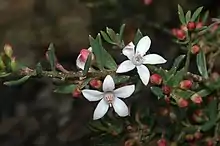Philotheca scabra
Philotheca scabra is a species of flowering plant in the family Rutaceae and is endemic to New South Wales. It is a small shrub with variably shaped leaves, depending on subspecies, and single white to pink flowers arranged on the ends of branchlets.
| Philotheca scabra | |
|---|---|
 | |
| Subspecies latifolia in the ANBG | |
| Scientific classification | |
| Kingdom: | Plantae |
| Clade: | Tracheophytes |
| Clade: | Angiosperms |
| Clade: | Eudicots |
| Clade: | Rosids |
| Order: | Sapindales |
| Family: | Rutaceae |
| Genus: | Philotheca |
| Species: | P. scabra |
| Binomial name | |
| Philotheca scabra | |
| Synonyms[1] | |
| |
Description
Philotheca scabra is a shrub that grows to a height of 0.6 m (2 ft 0 in) with more or less bristly stems. The leaves are sessile, 10–15 mm (0.39–0.59 in) long and either more or less cylindrical and folded lengthwise or narrow oblong-elliptic and concave on the lower side. The flowers are borne singly on the ends of branchlets on a peduncle 0.5–2 mm (0.020–0.079 in) long and a pedicel 2–5 mm (0.079–0.197 in) long with two pairs of tiny bracteoles at the base. There are five fleshy, semicircular sepals about 1 mm (0.039 in) long, five elliptical white to pink petals 7–8 mm (0.28–0.31 in) long and ten stamens. Flowering occurs in spring and the fruit is about 7 mm (0.28 in) long with a beak about 3 mm (0.12 in) long.[2][3]
Taxonomy
This philotheca was first formally described in 1844 by Joseph Paxton who gave it the name Eriostemon scaber and published the description in Paxton's Magazine of Botany from a specimen "in the nursery of Messrs. Henderson, of Pine Apple Place, who received it from the gardens of Baron Hugel, at Vienna, about twelve months back".[4][5] In 1970, Paul G. Wilson described two subspecies of Eriostemon scaber in the journal Nuytsia:[6]
- Eriostemon scaber subsp. latifolia (Paul G.Wilson) Paul G.Wilson that has glandular-warty stems and leaves about 12 mm (0.47 in) long and 3 mm (0.12 in) wide;
- Eriostemon scaber (Paul G.Wilson) Paul G.Wilson subsp. scaber that has smooth stems and more or less cylindrical leaves.[7]
In 1998, Wilson changed the species name to Philotheca scabra and the subspecies to P. scabra subsp. latifolia and P. scabra subsp. scabra respectively, in a later edition of the same journal:[7] The names of the subspecies are accepted by the Australian Plant Census:
Distribution and habitat
Philotheca scabra grows in heath and forest on the coast and nearby ranges of New South Wales between Sydney and the Nerriga and Nowra districts.[2][3] Subspecies scaber occurs in the northern part of the species' distribution and subsp. latifolius near Nerriga and Nowra.[7]
References
- "Philotheca scabra". Australian Plant Census. Retrieved 13 August 2020.
- Wilson, Paul G. (2013). Wilson, Annette J.G. (ed.). Flora of Australia (Volume 26). Canberra: Australian Biological Resources Study. p. 395. Retrieved 13 August 2020.
- Weston, Peter H.; Harden, Gwen J. "Philotheca scabra". Royal Botanic Garden Sydney. Retrieved 13 August 2020.
- "Eriostemon scaber". APNI. Retrieved 13 August 2020.
- Paxton, Joseph (1844). "Floricultural Notices". Paxton's Journal of Botany. 11: 190. Retrieved 13 August 2020.
- Wilson, Paul G. (1970). "A taxonomic revision of the genera Crowea, Eriostemon and Phebalium (Rutaceae)". Nuytsia. 1 (1): 44. Retrieved 13 August 2020.
- Wilson, Paul G. (1998). "A Taxonomic Review of the genera Eriostemon and Philotheca". Nuytsia. 12 (2): 259–260. Retrieved 13 August 2020.
- "Philotheca scabra subsp. latifolia". Australian Plant Census. Retrieved 13 August 2020.
- "Philotheca scabra subsp. scabra". Australian Plant Census. Retrieved 13 August 2020.